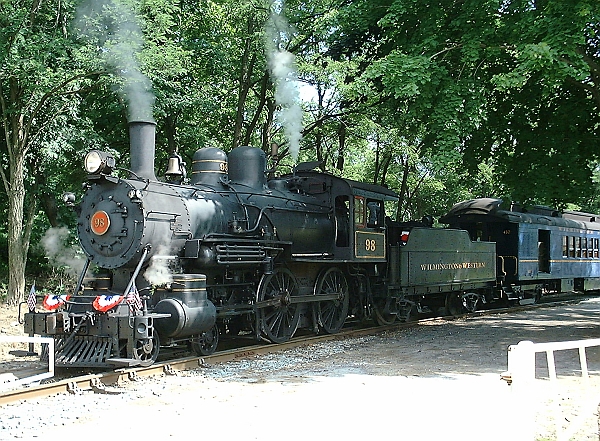
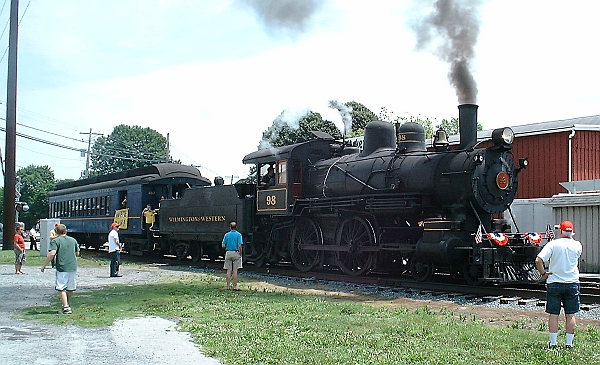
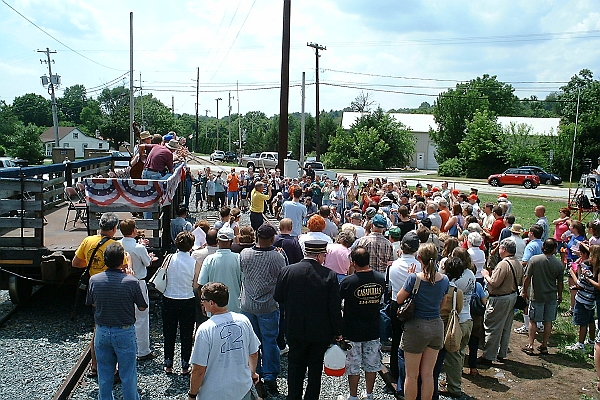
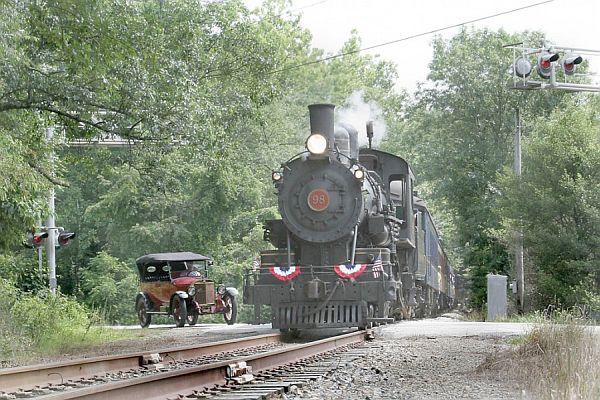 Photo courtesy of Mitch
Goldman
Photo courtesy of Mitch
Goldman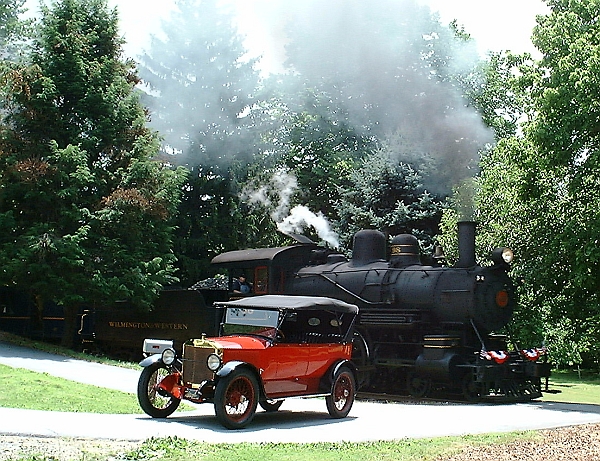
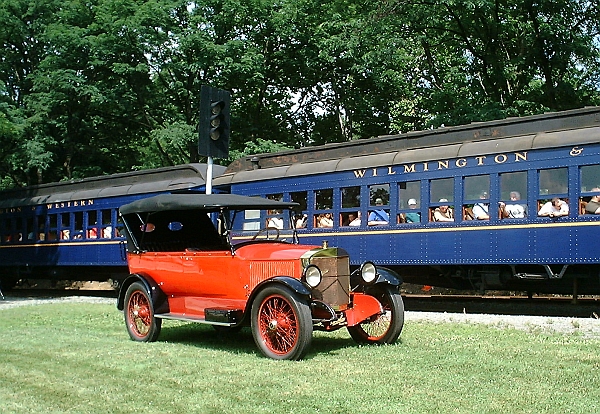
Wilmington & Western Railroad
Return To Hockessin
| In 1872 when the Wilmington & Western
Railroad was constructed it was common practice for railroads to build
their track along streams and rivers. This practice resulted in
lower construction costs and allowed many railroads to expand service
quickly. Railroads so constructed are often subjected to the
forces of Mother Nature and the WWRR's historic wooden trestles that
carry the tracks across the creek are no match to the catastrophic
forces of floodwaters. In September 1999 Hurricane Floyd dumped many inches of rain on the Red Clay Valley. Exceeding its 100-year flood height, the torrid waters of the Red Clay Creek rose nearly 14 feet and washed out two of the railroad's bridges. Repaired, trains operated until Tropical Storm Henri stalled over the Red Clay Valley in September 2003 and when the creek rose to 17.61 feet and washed out not only track but six of the railroad's 9 bridges (the two rebuilt after Floyd were undamaged as was a steel bridge on the line). With the assistance of FEMA, the governments of the State of Delaware and New Castle County, and grants from local foundations, businesses and individuals the railroad was rebuilt at the staggering cost of over $8,000,000. On June 30, 2007 trains from Greenbank Station once again were able to make the 10.2 mile trip to Hockessin, Delaware. A celebration was held to herald the "Return to Hockessin". |
 |
The first locomotive to be constructed with a 4-4-0 wheel arrangement was built in 1837 and soon became a popular choice for many American railroads. Known as an "American Standard," or simply "American" wheel arrangement, Locomotive 98 was built by the American Locomotive Company of Schenectady, NY in January 1909 (construction #45921). It worked in passenger service on the Mississippi Central before being retired in December 1944. Paulsen Spence purchased the 98 in 1947 for the Comite Southern, and later the Louisiana Eastern. |
 |
Thomas C. Marshall purchased the locomotive in January 1960 with the intent of operating her on a proposed weekend steam tourist railroad in Wilmington, DE. Tom donated the locomotive to Historic Red Clay Valley, Incorporated (operator of the WWRR) in December 1977. She operated regularly until the end of 1998 when she was removed from service to undergo a major rehabilitation project.98 made a triumphant return to the rails on October 2004 and is the only coal-fired 4-4-0 locomotive in regular service today. The locomotive is named the Thomas C. Marshall, Jr. |
 |
It had been 3 years, 7 months. and 15 days since a train made its way along the Landenberg Branch of the former B&O line to reach Hockessin. The event was celebrated by a crowd of several hundred including volunteers and individuals instrumental to the railroad's reconstruction. After several speeches, HRCV Executive Director David Ludlow drives a golden spike to mark the occasion. More information on the line is available at www.wwrr.com. |
 Photo courtesy of Mitch
Goldman Photo courtesy of Mitch
Goldman |
The WWRR was chartered in 1867 to move goods between the mills along the Red Clay Creek and the Port of Wilmington, and officially opened for freight and passenger service on October 19, 1872. Excessive construction debts and poor management caused the line to fall into foreclosure in 1877. Reorganized as the Delaware Western Railroad the line became highly profitable moving Kaolin Clay, vulcanized fiber materials, snuff, iron and coal to and from the mills. In the 1880s, the line was purchased by the Baltimore & Ohio Railroad. Purchase of the line by the B&O provided access to compete with the Pennsylvania Railroad for passengers and freight traveling between Washington and New York City. The line became known as the "Landenberg Branch" by the B&O and was, for a time, its most profitable branch line. |
 |
In the mid 1960s, HRCV was formed and began leasing the Landenberg Branch from the B&O on weekends to operate steam-powered tourist trains between Greenbank and Mt. Cuba. In the mid-1970s, the line's new owner, The Chessie System, determined that the line had become a financial burden and filed for abandonment. With the line due to be demolished, fundraising began by HRCV to purchase the 64-acres of right-a-way from Marshallton to Hockessin. In August of 1982, the remaining 10.2 miles of the Landenberg Branch were purchased by HRCV. |
 |
The WWRR's coaches were built in 1914 by the Pullman Company as part of an order for 77 cars built for commuter service on the Delaware, Lackawanna & Western Railroad. Featuring distinctive steel I-beam platform roof supports, railfans nicknamed them "Boontons" as they were a familiar site along the DL&W's Boonton Branch through Boonton, NJ. No longer in service in the mid-1960s, HRCV purchased the cars for use on the WWRR. Each car weighs 108,000 lbs. and feature original Hale & Kilburn cane-covered walkover seats, and wrought-iron overhead luggage racks. |